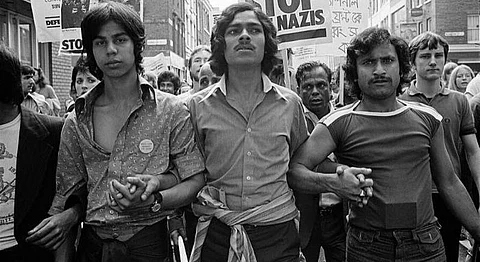
- HOMEGROWN WORLD
- #HGCREATORS
- #HGEXPLORE
- #HGVOICES
- #HGSHOP
- CAREERS
- ABOUT US
- CONTACT US

At the entrance to the Altab Ali Park in Adler Street in East London is an arch created by David Petersen, developed as a memorial to Altab Ali, a Bangladeshi worker who had migrated to Britain in 1969. He was one amongst a large group of South Asians who had come to Britain following WWII after the independence of Pakistan, India, Sri Lanka and Bangladesh. He had arrived with his uncle as a teenager in London, where he worked in Hanbury Street, off Brick Lane, where the Bengali community lived. Ali returned to Bangladesh for five months in 1975 and got married. When he came back to England, his bride stayed with his parents. The plan was that she would join him later. She never did.
On May 4, 1978, as Ali was walking home from work along Adler Street, near St Mary’s Gardens, he was attacked and stabbed by three teenagers, whose minds had been poisoned by racists. Later at their trial, they would say they attacked Ali because he was a ‘Paki’. This was one among a slew of racially-motivated attacks on South Asians in Britain in the 20th century. Ali’s murder was symptomatic of the racial antagonism stirred up in the 1970s. Extreme white supremacist groups such as the National Front had started engaging in organised and systematic patterns of violence against the local Bangladeshis of East London, using slogans such as ‘Blacks Out’, ‘White is Right’, and ‘Kill the Black Bastards’.
Brick Lane, where Ali lived, was a dangerous place to be in, in the 1970s. Skinheads and elements of the extreme Far Right from all over east London came to indulge in routine acts of ‘Paki bashing’ in the neighbourhood. However, these racially motivated violent acts were mainly carried out by an extremist minority, and many Bangladeshis lived harmoniously with their white working-class neighbours.
Having said that, Ali’s murder was a significant turning point for race relations in East London, which was already infamous for having been witness to the protest march against the large Jewish population by Oswald Mosley’s British Union of Fascists in 1936.
In the wake of Ali’s murder, the local Bangladeshi community was galvanized into political action, heightening the call for social justice and equality among many other ethnic minority communities across the UK. The murder sparked off a series of demonstrations and protests across East London. On May 14, 7,000 Bengalis held a protest march from Brick Lane to Downing Street behind Altab Ali’s coffin. The Trades Council report, Blood on the Streets, correctly described this march as “one of the biggest demonstrations by Asians ever seen in Britain.” The protesters demanded better police protection and also highlighted wider issues of institutionalised racism. Their placards read: “Self-defence is no offence” and “Here to stay, here to fight”.
Several other protests took place in Brick Lane, following another racially-motivated mob violence in the area on June 11 when mobs of youth attacked the Bengali community residing in East End London. About 150 youths rampaged through the Brick Lane district, smashing windows, throwing bottles and lumps of concrete, and damaging shops and cars.
When an Asian man name Ishaque Ali was killed in the racially-motivated attack in Hackney on June 26 of the same year, it marked a new stage in the escalation of racial violence in the area. The Times observed: “Attacks on Bengalis in the Brick Lane area of Spitalfields have usually been the work of relatively small groups. The destruction yesterday was carried out by the largest gang to assemble and threaten Asians in that area.”
This brought anti-racism groups and the National Front into tense conflict at nearby Bethnal Green, where skinheads would distribute their literature on Sundays.
On Sunday, August 20, there was another march organised by the Anti-Nazi league to celebrate the departure – temporary as it turned out – of the National front sellers from Brick Lane. This involved 5,000 people, mainly White.
Though the process was gradual, far-right groups lost their influence in east London over the following decade and violent attacks became less frequent. The protests after the murder of Mr Ali showed a community no longer willing to suffer the violence of racists without fighting back. To build on this legacy, John Biggs, the Mayor of Tower Hamlets, announced in October 2015 that the borough would host an annual Altab Ali Commemoration Day from that year onward.
The day conveys the message that community co-operation can defeat new forms of discrimination going forwards.
If you enjoyed reading this article, we suggest you also read:
